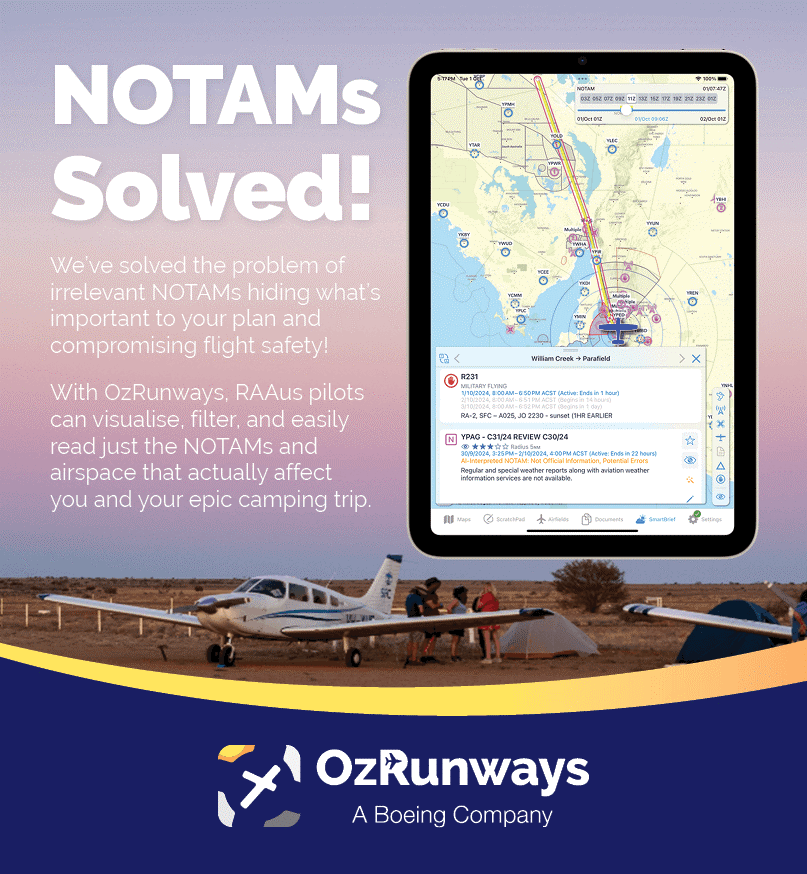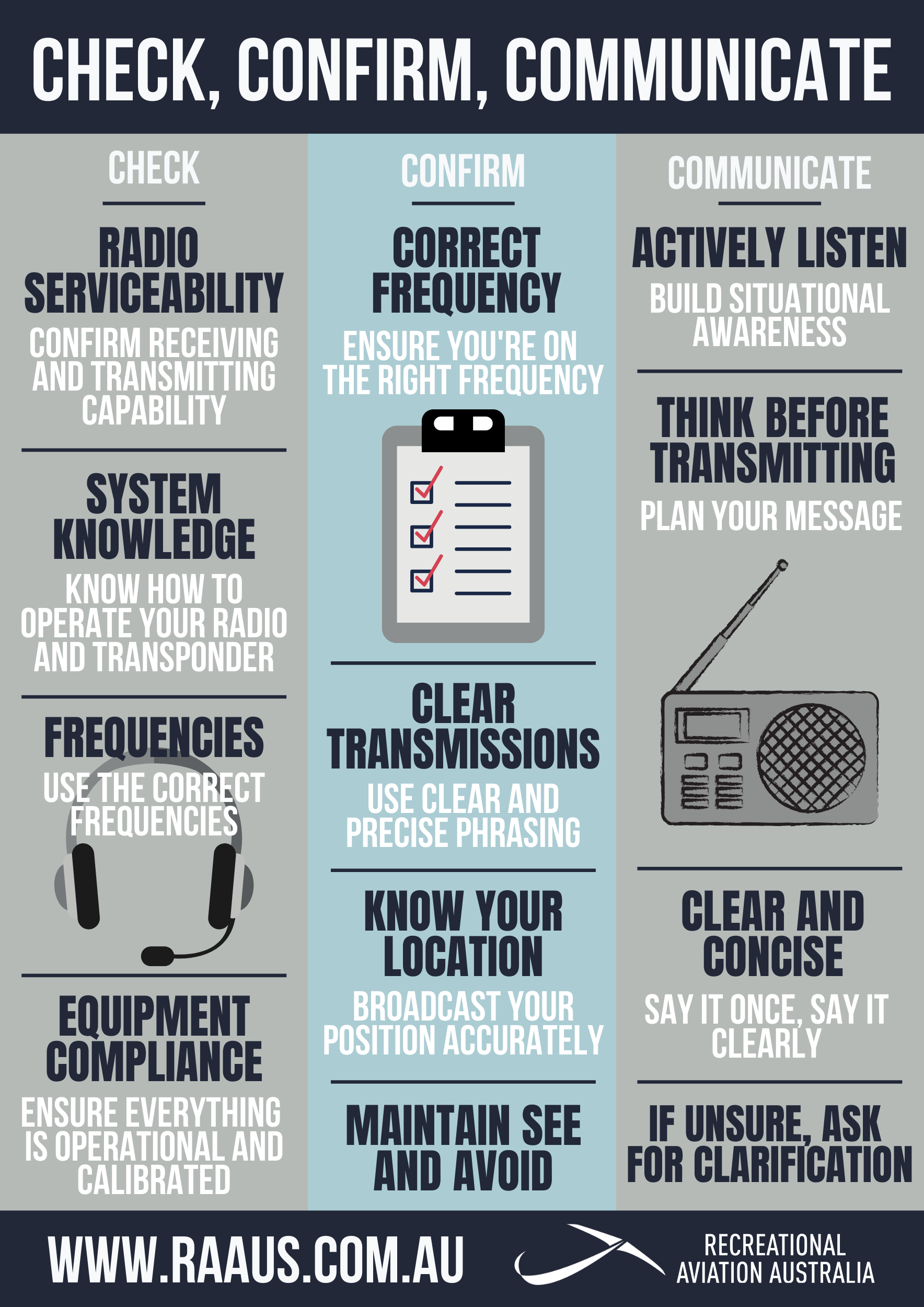Welcome to Week 5 of National Safety Month 2024
Proudly Sponsored by:
The OzRunways team includes Australian pilots who understand the unique challenges of Australian flying. They support the Recreational Aviation community and are committed to improving safety standards through National Safety Month.
Their EFB tools, focusing on Weather, Traffic & NOTAMs, are essential for pilots at all skill levels. OzRunways ensures pilots can easily access safety information for every flight. With advanced tools, they make flying simpler and, most importantly, safer!
How OzRunways Graphical NOTAMs Improve Pilot Safety
Recreational pilots have always faced a serious problem with NOTAMs: too many irrelevant ones cluttering flight planning. Sorting through lengthy lists of NOTAMs to find the ones that actually mattered was time-consuming and increased the risk of missing critical information, jeopardising flight safety rather than enhancing it.
OzRunways has solved this problem. By extracting geolocation data from every NOTAM in Australia, they’ve transformed the old, cumbersome lists into visual, graphical NOTAMs displayed on the SmartBrief map. This allows OzRunways Premium subscribers to quickly visualise and filter only the NOTAMs relevant to their flight, specifically those that intersect the flight path within a +/- 5nm range.
This enhancement to flight planning is significant: it improves situational awareness, reduces distractions, speeds up decision-making, and makes it easier to digest relevant information—all leading to safer flights. Pilots can expect a reduction of around 80% in the number of NOTAMs displayed by using the ‘NOTAMs for Plan’ filtering toggle inside SmartBrief. See a demonstration of this tool in action in the short YouTube video below.
The OzRunways NOTAMs tool is the solution to a long-standing problem, giving you the confidence that you’re briefing with up-to-date, relevant information. It’s a crucial safety tool that provides peace of mind, cuts the clutter, and lets you focus on getting airborne sooner.

The gorilla you never saw coming
Every year, hundreds of pilots have their own ‘invisible gorilla’ moment flying in uncontrolled airspace. In clear skies, with good visibility, experienced pilots still find themselves asking ‘How did I miss seeing that aircraft?’ What’s your gorilla? And more importantly, how do you spot it before it matters?
The Invisible Threat
The famous ‘invisible gorilla’ experiment showed that when people concentrate on counting basketball passes, they often miss a person in a gorilla suit walking right through their field of view. Why? Because focusing intently on one task can make us blind to other, often obvious things happening around us.

When Reality Hits
Consider this real incident from June 2015 near Quirindi, New South Wales. Two training flights – a CT/4B conducting instrument training and a DA-40 on a navigation exercise – demonstrated just how easily this can happen in the air. Despite clear weather conditions, the aircraft came within 60 meters laterally of each other at the same altitude. Operating on different frequencies while managing multiple tasks, neither crew knew about the other until a traffic collision avoidance alert triggered evasive action.
Understanding the Risks
ATSB research reveals some sobering facts:
- A search for other traffic is eight times more effective when using both radio and visual scanning
- Most incidents occur in clear weather conditions
- The highest risk of traffic conflict occurs in the circuit area
- Insufficient communication between pilots is the most common cause of safety incidents
Managing Mixed Traffic
The challenge of uncontrolled aerodromes often isn’t just about traffic volume – it’s about mixing different types of flying. From general aviation (which includes RAAus aircraft) to training and larger passenger transport, each brings different performance characteristics and needs. As highlighted in AC 91-10, understanding this mixture is crucial for maintaining situation awareness. Modern tools like traffic features in EFBs can enhance your situational awareness, but they’re just one tool in your safety toolkit.
Communication is Key
Clear, concise radio calls at standard circuit positions form the foundation of safety at non-controlled aerodromes. Active listening is just as important as broadcasting; monitor the frequency well before entering the circuit area to build a mental picture of the traffic flow. Don’t let silence lull you into complacency; some aircraft may not be equipped with radio. If uncertain about another aircraft’s position or intentions, ask for clarification.
Circuit Discipline
Maintaining standard circuit heights and paths creates predictability; helping everyone anticipate potential conflict points. AC 91-10 emphasises that while safety might occasionally require deviation from standard procedures, being predictable helps others plan their own flying safely. The base to final turn demands particular attention, combining high workload with critical decision making.
Making Yourself Visible
Safe flying in busy uncontrolled environments requires a systematic approach:
- Use aircraft lighting even in daylight conditions
- Make clear broadcasts of your position and intentions
- Maintain appropriate circuit spacing
- Keep patterns predictable
- Stay extra vigilant at known conflict points:
- Circuit joining
- Base turn
- Final approach
The Final Word
The ATSB’s research makes it clear: combining active communication with vigilant lookout dramatically improves our chances of spotting potential conflicts. This works when we:
- Maintain active communication
- Recognise our attention limitations
- Use all available resources
- Never assume we’re alone
Remember: The most dangerous gorilla isn’t the one you see – it’s the one you’re absolutely certain isn’t there.
CODE WORD: COLLABORATION
Case study details from ATSB Transport Safety Report, Aviation Occurrence Investigation AO-2015-060
Safety guidance from AC 91-10 v1.2 – Operations in the vicinity of non-controlled aerodromes
OPERATING AT NON-CONTROLLED AERODROMES
Could a circuit collision happen at your local airfield? Learn vital lessons from a real helicopter-aircraft incident that occurred at one of our busy uncontrolled aerodromes. An expert panel breaks down exactly what went wrong and shares essential tips for safer operations: mastering your radio calls, understanding how different aircraft move in the circuit, and building the situational awareness you need to stay safe. Don’t miss these critical insights for every pilot operating at non-controlled aerodromes.
Click on the image to download the print-ready poster!
You have to be in it to win it!

Don’t forget to revisit and read all of the content from the five weeks of National Safety Month 2024! Engaging with this material will give you the chance to enter our exciting prize draws.
Keep in mind that all entries for the prize draws will close on 3 November 2024, so make sure to participate before the deadline. Don’t miss out on your opportunity to win amazing prizes while enhancing your knowledge about safety!
PARTICIPATE TO WIN!
Read and watch the content above, then enter your details and the hidden code word to enter our Week 5 prize draw!
YOU COULD WIN ONE OF THE FOLLOWING PRIZES*
FIRST PRIZE AND SECOND PRIZE: iPad Mini 64GB + OzRunways Subscription
Valued at $1,278 each
THIRD PRIZE AND FOURTH PRIZE: FLYTE Sunglasses
Sponsored by FLYTE
Valued at $245 each

*Applicants must hold a current Flying Membership or Non-Flying Membership in order to win the first and second prize.
*Terms and Conditions apply


